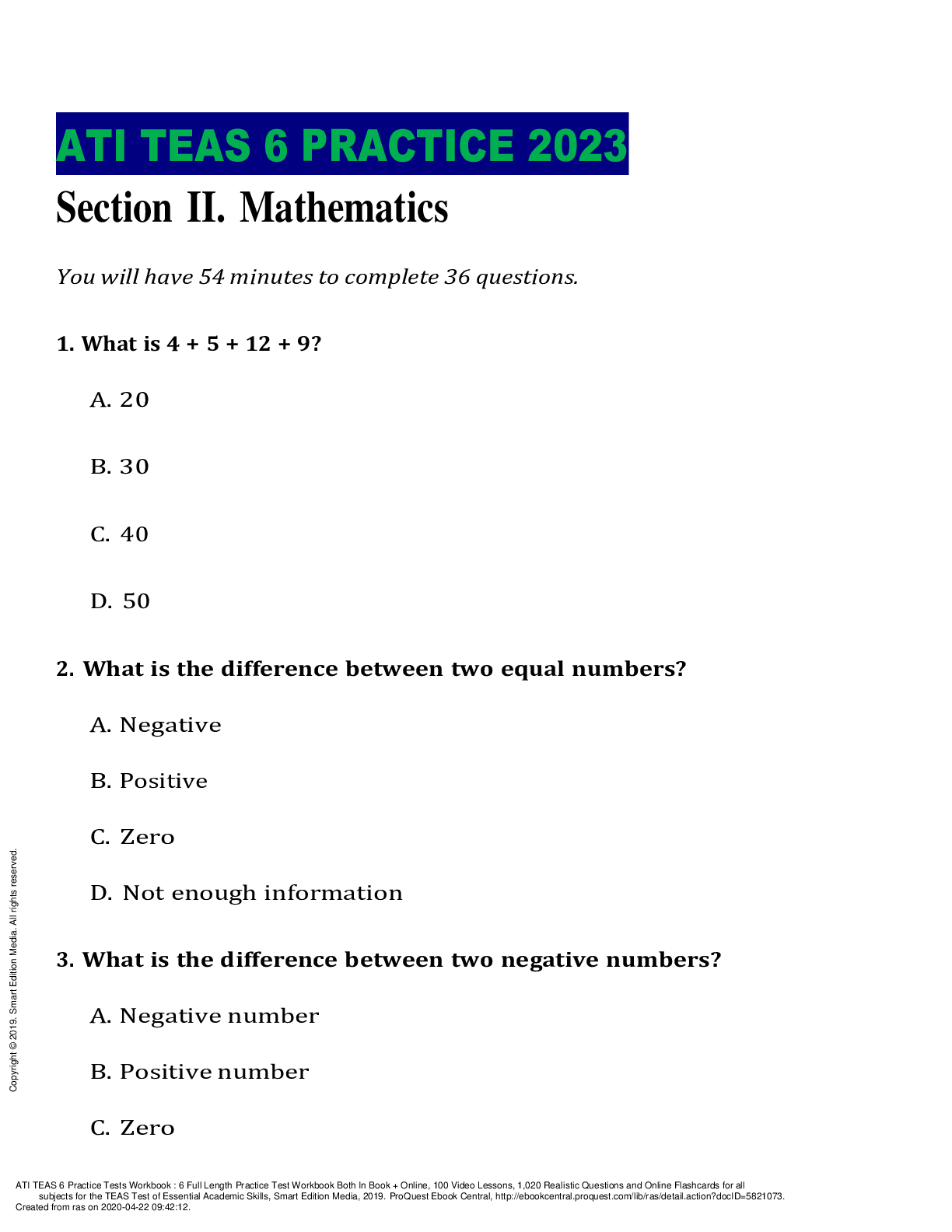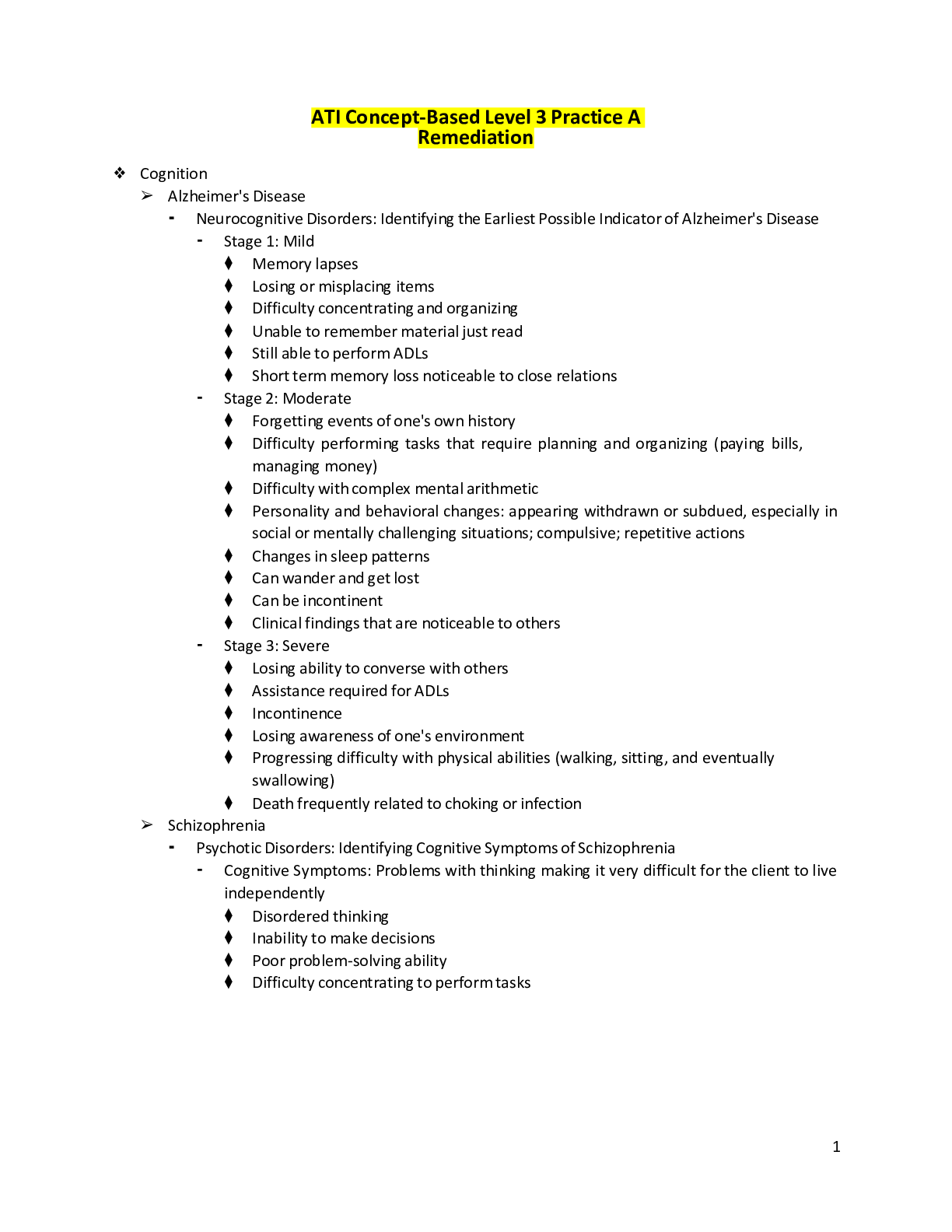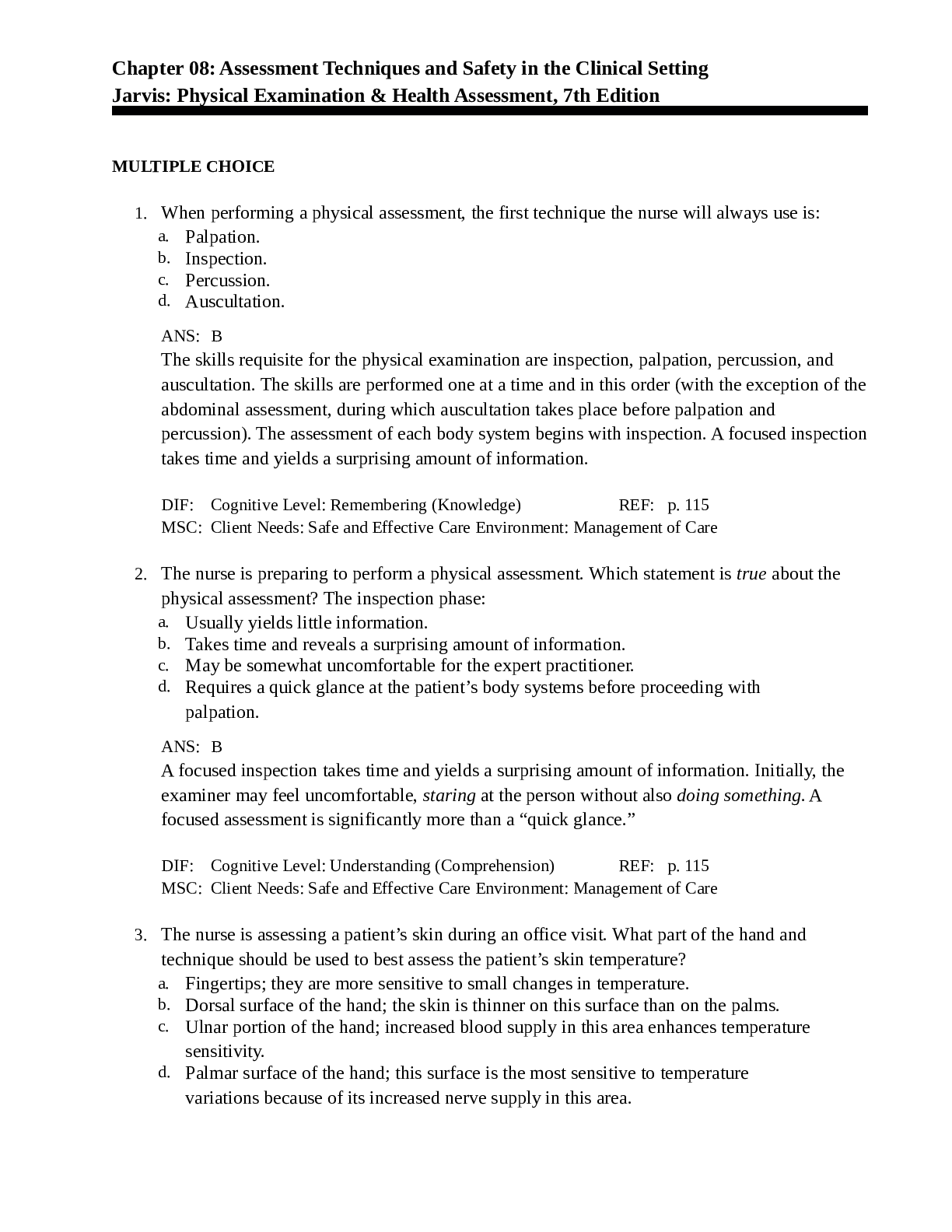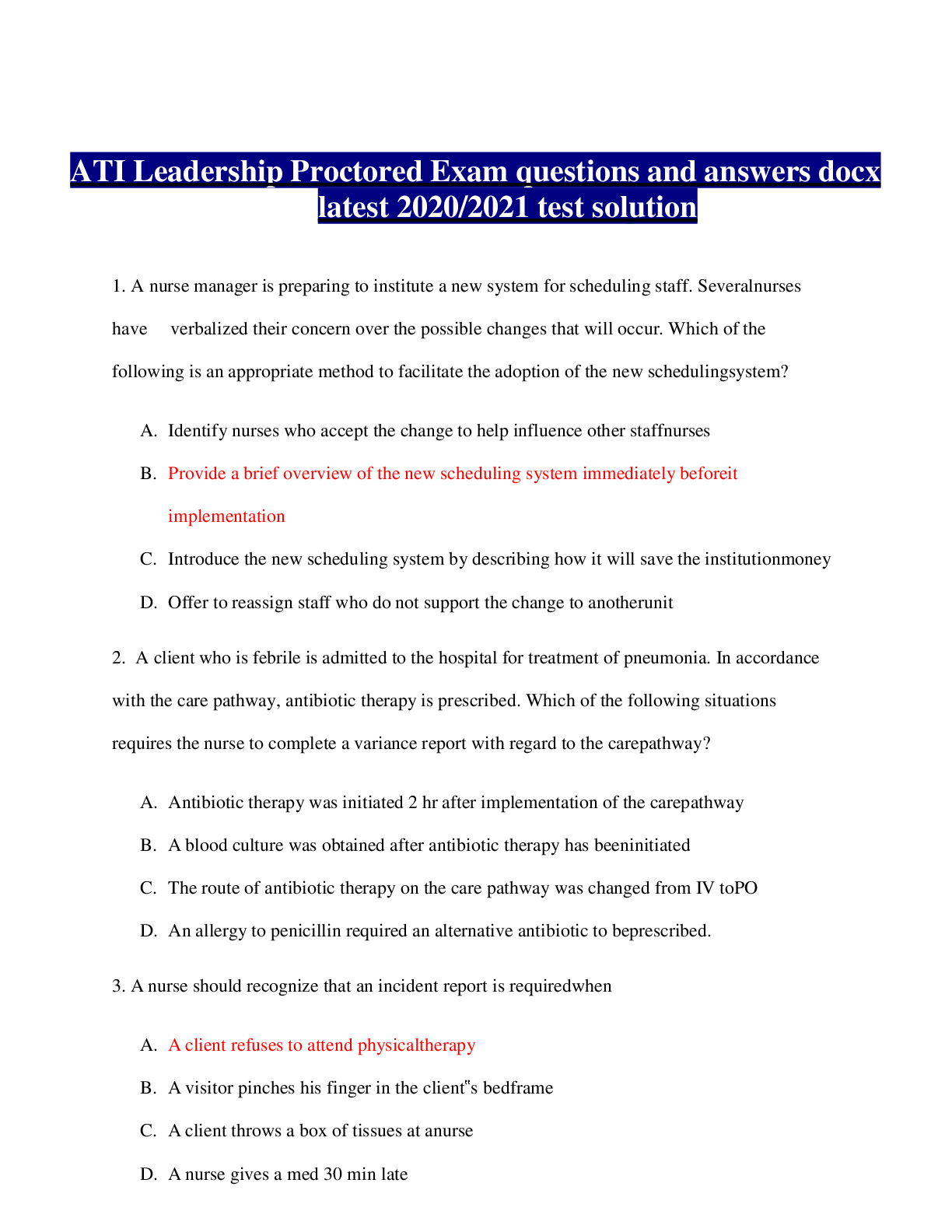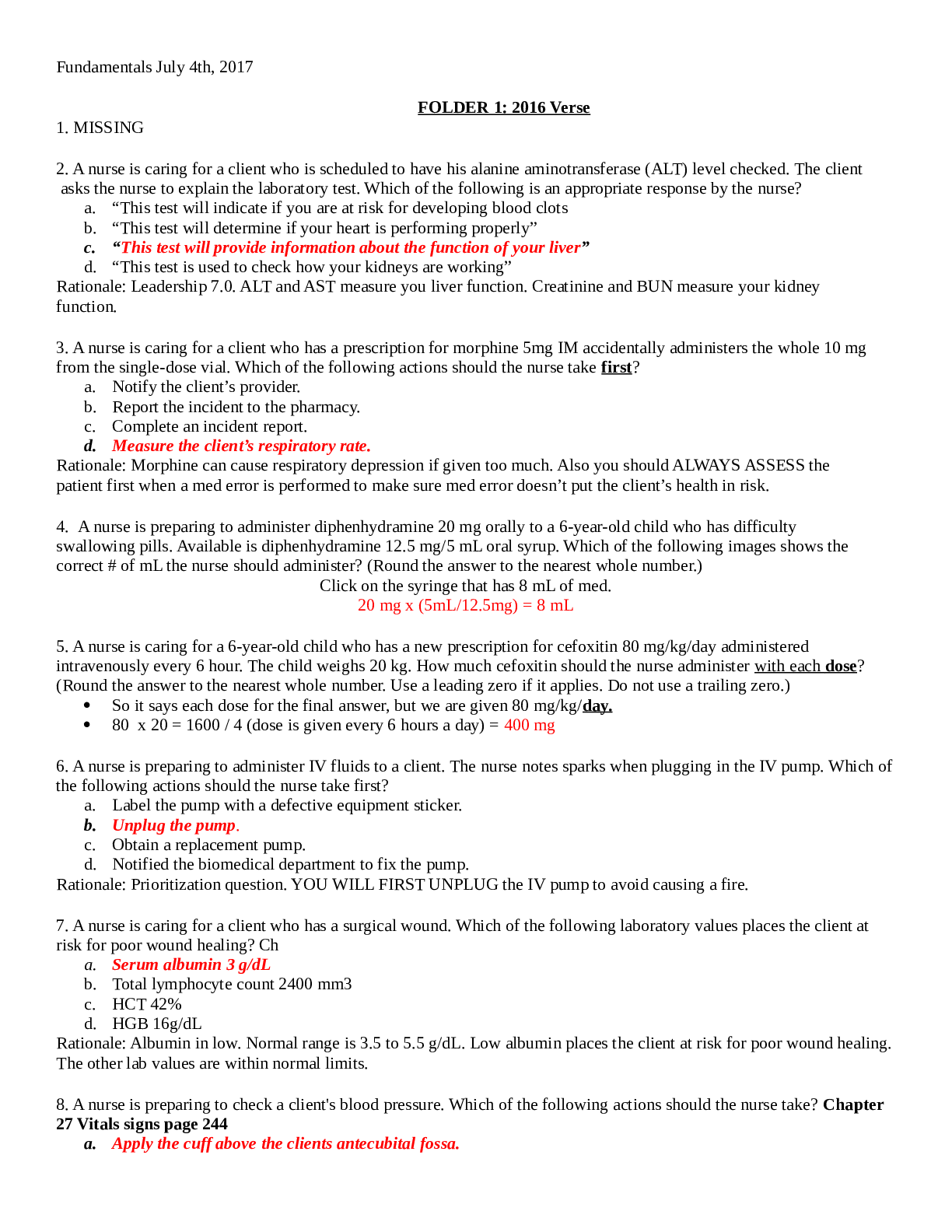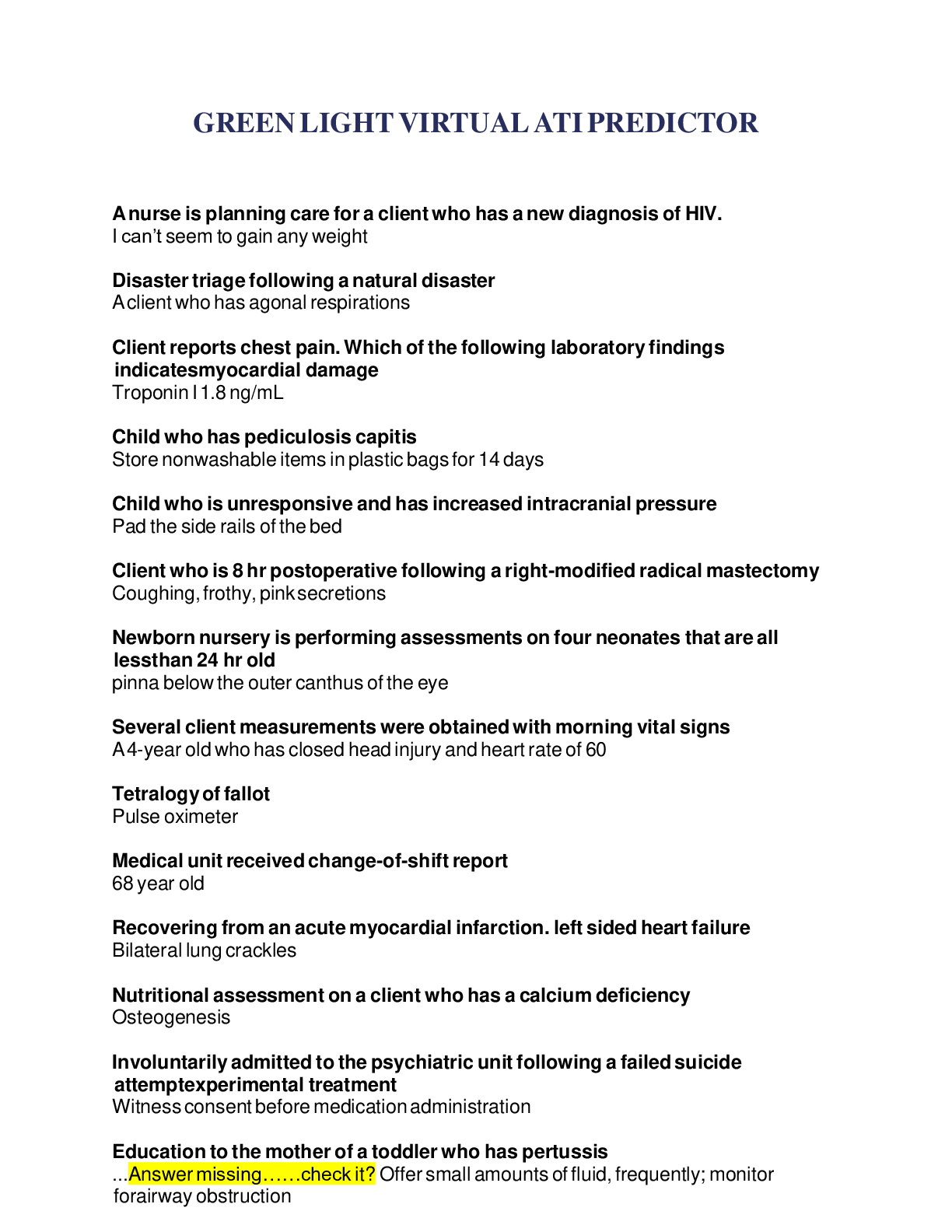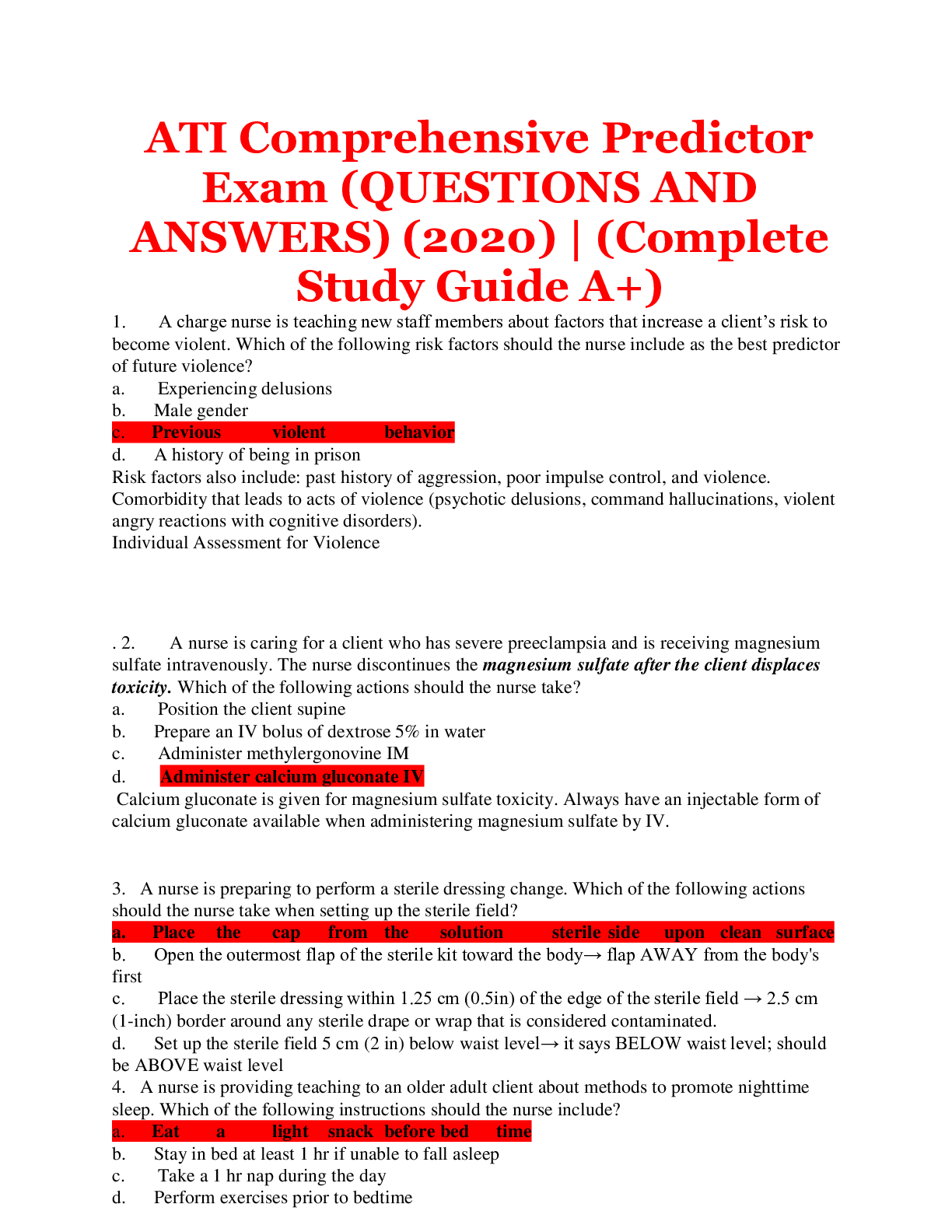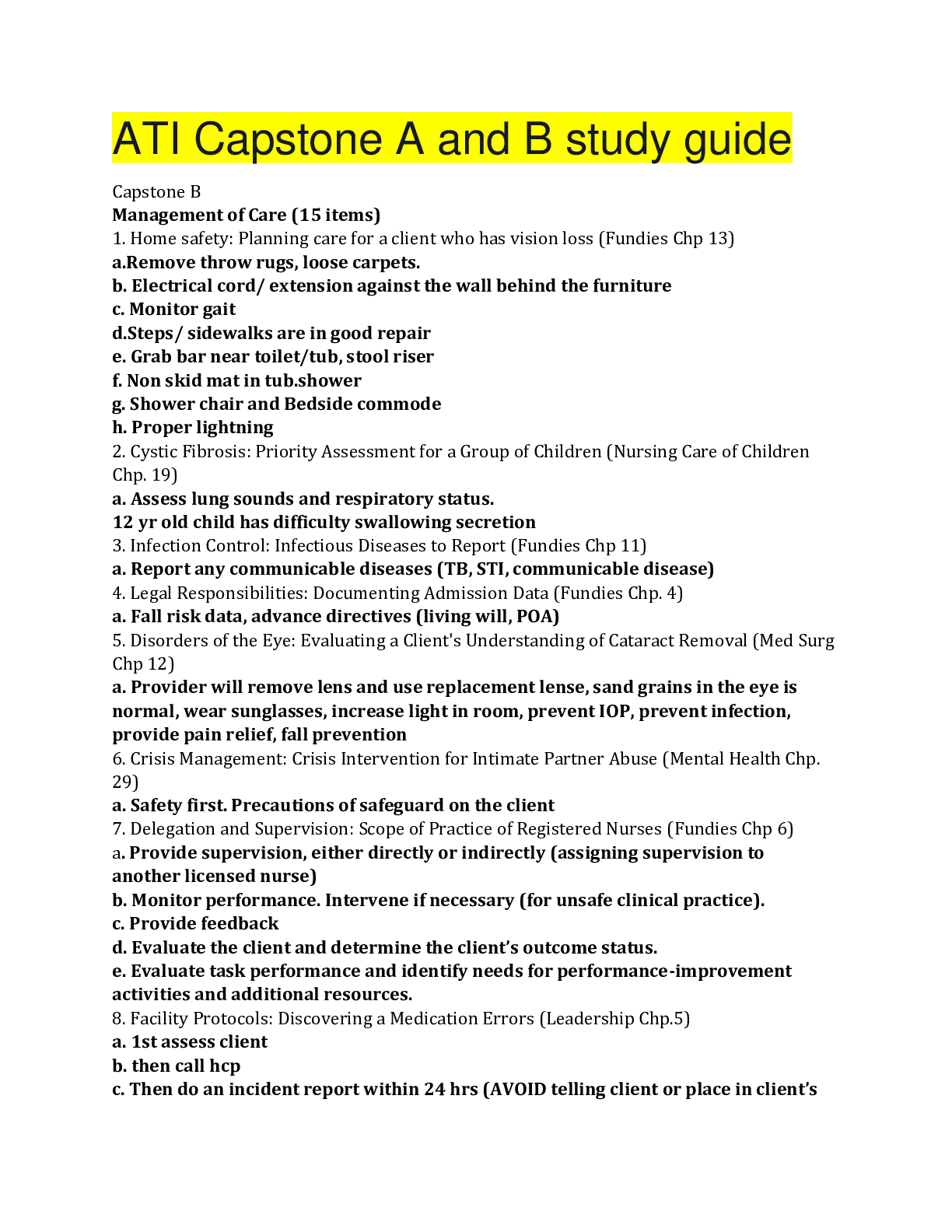*NURSING > QUESTIONS and ANSWERS > ATI FUNDS’ Safety & infection control Quiz; questions and answers(all correct) lATEST 2021 (All)
ATI FUNDS’ Safety & infection control Quiz; questions and answers(all correct) lATEST 2021
Document Content and Description Below
ATI FUNDS’ Safety & infection control Quiz; questions and answers(all correct) A client has a new tracheostomy. Which of the following interventions should the nurse include when performing tracheo... stomy care? Select one: a. Clean disposable inner cannula with hydrogen peroxide. b. Change tracheostomy ties when soiled. c. Suction the tracheostomy before beginning care. d. Remove soiled dressing with sterile gloves. A client has fallen in the bathroom. Which of the following is the priority nursing action? Select one: a. Notify the healthcare provider b. Assess the client’s level of consciousness c. Assist the client back to bed d. Obtain the client’s vital signs A nurse is providing discharge education for a female client diagnosed with Chlamydia. Which statement made by the client would indicate the need for further instruction? Select one: a. “Symptoms of reinfection may include yellow vaginal discharge.” b. “Possible complications to monitor for include pelvic inflammatory disease.” c. “I will return to the clinic in one month for re-screening.” d. “I will refrain from sexual intercourse until completion of antibiotics.” A nurse is caring for a client with a diagnosis of sepsis with a temperature of 40.8 C (105.5 F). The provider has ordered a cooling blanket. Which intervention is appropriate to delegate to an Unlicensed Assistive Personnel (UAP)? Select one: a. Assess the client’s skin for any reddened b. Obtain a fan for the client’s use c. Bathe the client to keep the skin damp d. Report shivering by the client A nurse is triaging clients following a mass casualty event. The nurse should place a client who has sustained fatal injuries in which of the following triage categories? Select one: a. Emergent Category (Class I) b. Urgent Category (Class II) c. Nonurgent Category (Class III) d. Expectant Category (Class IV) A nurse is positioning a client for a urinary catheterization. Which of the following nursing actions would be best in preventing musculoskeletal injuries during the procedure? Select one: a. Narrowing the base of support. b. Raising the bed to a comfortable height. c. Positioning the client using a draw sheet. d. Using the non-dominant hand to insert the catheter. A nurse is caring for an older adult client with delirium. Which intervention will most effectively reduce the client’s risk for falls? Select one: a. Place bedside table in close proximity. b. Hourly rounding by the nurse. c. Demonstrate how to use the call light. d. Use of a night-light. A fire in a first floor operating room is forcing evacuation of clients from a second floor unit to another building. Which of the following clients would have the highest priority for the charge nurse to evacuate? Select one: a. A client receiving IV antibiotics every six hours for a leg ulcer. b. A client admitted with pancreatitis with nasogastric tube and PCA pump in place. c. A client semi-comatose after a cerebrovascular accident with an indwelling urinary catheter. d. A client post left hip replacement of two days ago whose daughter is visiting. A nurse is providing the family of a client with acquired immunodeficiency syndrome (AIDS) education in preparation for discharge. A family member asks about appropriate clean up of blood or body fluids. Which of the following is the correct response by the nurse? Select one: a. Disinfect the area with a 10% bleach solution after initial cleaning. b. Use soap and water to clean, rinse thoroughly, and allow the area to air dry. c. Clean the area with soap and water and rinse thoroughly with ammonia. d. Disinfect the area with 70% isopropyl alcohol after initial cleaning. A nurse is caring for a client when the IV infusion pump malfunctions and delivers 1 Liter of IV fluid over 2 hours. Which intervention is the priority? Select one: a. Monitor urine output. b. Fill out an incident report. c. Report the defective equipment. d. Document the amount of fluid infused. A graduate nurse is caring for a client who is on neutropenic precautions. Which of the following actions by the nurse would require further teaching by the charge nurse? Select one: a. Discarding an empty blood bag and blood tubing in the client’s beside trash can. b. Disposing of a used needle and syringe in the biohazard box in the client’s room. c. Taking an infusion pump from the bedside of a client to the dirty utility room. d. Taking a blood pressure cuff to the bedside of a client on neutropenic precautions. A newly-licensed nurse is preparing the surgical suite for a client who has a latex allergy. Which action demonstrates a need for further education? Select one: a. Placing monitoring devices in stockinet. b. Covering IV tubing ports with tape. c. Scheduling the case late in the day. d. Using glass syringes. A nurse is orienting a newly licensed nurse to the operating room. Which of the following actions by the new nurse indicates a need for further education about surgical aseptic hand hygiene? Select one: a. Rinsing hands and arms while keeping them lower than elbows. b. Cleaning under nails of both hands with a nail pick while under running water. c. Drying with a sterile towel moving from the hands to the elbows. d. Lathering hand and arms with soap to 5 cm (2 inches) above the elbows A client has just returned to the surgical unit after an open cholestectomy. A nurse notes the abdominal dressing is saturated with sanguineous drainage. Which of the following is the most appropriate intervention? Select one: a. Document the assessment findings. b. Outline the drainage size with a marker. c. Remove the dressing to assess the incision. d. Reinforce the dressing with additional gauze. The parents of an adolescent client ask the nurse why the meningiococcal conjugate vaccine is recommended before attending college. Which of the following statements best explains the reason why college-aged students should receive this vaccine? Select one: a. Adults who contract meningitis rarely have complications from it. b. Receiving the vaccine provides guaranteed immunity to the disease. c. Upper respiratory infections are more common on college campuses. d. Living in a dormitory increases the risk of exposure to the disease. A nurse is instructing a client with a right fractured tibia on the correct technique for using a three-point gait with crutches. Which of the following should be included in teaching? Select one: a. Partial weight is placed on the right foot moving the crutch at the same time as the right leg. b. Weight is placed on both legs, and crutches are placed one stride in front and then legs swing to the crutches. c. Weight is evenly distributed, with each leg being moved alternately with the opposing crutch. d. Weight is distributed on both crutches and then on the unaffected leg with the sequence being repeated. A nurse is educating a parent of a newborn about safety measures. Which of the following statements made by the client would indicate a need for further teaching? Select one: a. “My baby’s car seat should be in the back seat facing backwards.” b. “I should never leave my baby unattended with pets or other children.” c. “I should always support my baby’s head when I pick him up.” d. “Once my baby begins to roll over it is okay to use a small pillow in the crib.” A nurse is providing a tour of the labor and delivery unit to expectant parents. Which statement made by the mother indicates a need for further education? Select one: a. “We will need to remove the baby’s ankle identification band during diaper changes.” b. “We will request to see picture identification badges for all facility staff who care for our baby.” c. “When the baby is returned to us from the nursery, we should check the baby’s identification band.” d. "When the baby is born, my thumb print will be taken along with the baby’s footprint.” A client with pneumonia has an oxygen saturation of 85%, heart rate of 88, respiratory rate of 22, and blood pressure of 132/88. Which of the following is the priority nursing intervention? Select one: a. Immediately notify the provider b. Administer albuterol inhaler c. Place the client on 2 Liters oxygen d. Reassess pulse oximetry A nurse is caring for a client diagnosed with an acute anxiety disorder. Which of the following is the priority nursing intervention? Select one: a. Remain with the client during the crisis period. b. Administer prescribed selective serotonin inhibitor (SSRI). c. Encourage to attend a behavioral therapy group. d. Evaluate coping mechanisms for controlling anxiety. When the nurse takes morning medications to a client, the client states “I’ve never seen that one before.” Which of the following is the most appropriate action for the nurse to take? Select one: a. Return to the nurse’s station and check all medications against provider orders b. Administer the rest of the medications and recheck the one that was questioned. c. Tell the client that the medication must be new and to go ahead and take it. d. Recheck the medication with the medication administration record (MAR). A nurse is providing staff development. The nurse understands that which of the following may impede learning? Select one: a. Intrinsic motivation. b. Proven learner. c. Self-directed. d. Self-confidence. A client is receiving chemotherapy and reports that the tubing has pulled apart and notices a puddle on the floor. Which of the following is the priority nursing action to take after ensuring the client is stable and appropriate tubing disposal? Select one: a. Complete an incident report about the spill. b. Notify housekeeping of the spill. c. Soak up the spill with a towel and dispose of it in a biohazard bag. d. Obtain the spill kit specifically designated for this type of spill and use it. A client being admitted to a nursing unit asks the nurse, “My friend has carpal tunnel syndrome and said I would probably get it too because of my work. What can I do to prevent it?” Which of the following statements would be the nurse’s best response? Select one: a. “Find out if other family members have it because it is hereditary.” b. “Consider asking for a different job if your wrists start to bother you.” c. “Begin a supervised exercise program to strengthen both of your wrists.” d. “Keep your wrists in a neutral position or wear wrist braces for support.” A nurse is caring for multiple clients on the acute care unit. Which action demonstrates effective time management? Select one: a. Document all client care activities at the conclusion of the shift. b. Complete difficult tasks after simpler tasks have been completed. c. Cluster activities that are to be performed on the same client. d. Avoid delegation of tasks to other members of the health care team. A nurse is preparing to transfer a client from the bed to a stretcher. Which action increases the nurse’s risk for injury? Select one: a. Standing with feet wide apart. b. Manually lifting the client’s full weight. c. Keeping knees slightly flexed. d. Encouraging the client to assist. A hospital has been notified that possible bioterrorist activity has taken place at a large sporting event nearby. A nurse has been put in charge of preparing a holding area to meet the needs of victims who report headache, dizziness, anxiety and shortness of breath, and are noted to have a bitter almond odor to their breath. What medication should the nurse be prepared to administer? Select one: a. Cyanide vaccine b. Amyl Nitrate c. Vitamin K d. Acetylcysteine A nurse is educating an older adult about food safety in the home. Which of the following instructions should the nurse include in teaching? Select one: a. Clients at risk for food poisoning should follow a low cholesterol diet. b. The older adult recovers from food poisoning in a few days. c. Food poisoning is usually caused by a fungus. d. When preparing a meal raw and fresh foods should be handled separately. A nurse applies restraints to a mental health client who is refusing to take his antipsychotic medication. The nurse may be charged with which of the following intentional torts? Select one: a. Assault b. False Imprisonment c. Negligence d. Malpractice A nurse is caring for a client following a right below the knee amputation. Which of the following should the nurse include in the plan of care to prevent infection? Select one: a. Encourage the client to lie supine for 20-30 minutes several times a day. b. Encourage the client to lie prone for 20-30 minutes several times a day. c. Position the affected limb elevated on a pillow. d. Position the affected limb in a dependent position. [Show More]
Last updated: 1 year ago
Preview 1 out of 10 pages

Reviews( 0 )
Document information
Connected school, study & course
About the document
Uploaded On
Feb 14, 2021
Number of pages
10
Written in
Additional information
This document has been written for:
Uploaded
Feb 14, 2021
Downloads
0
Views
40



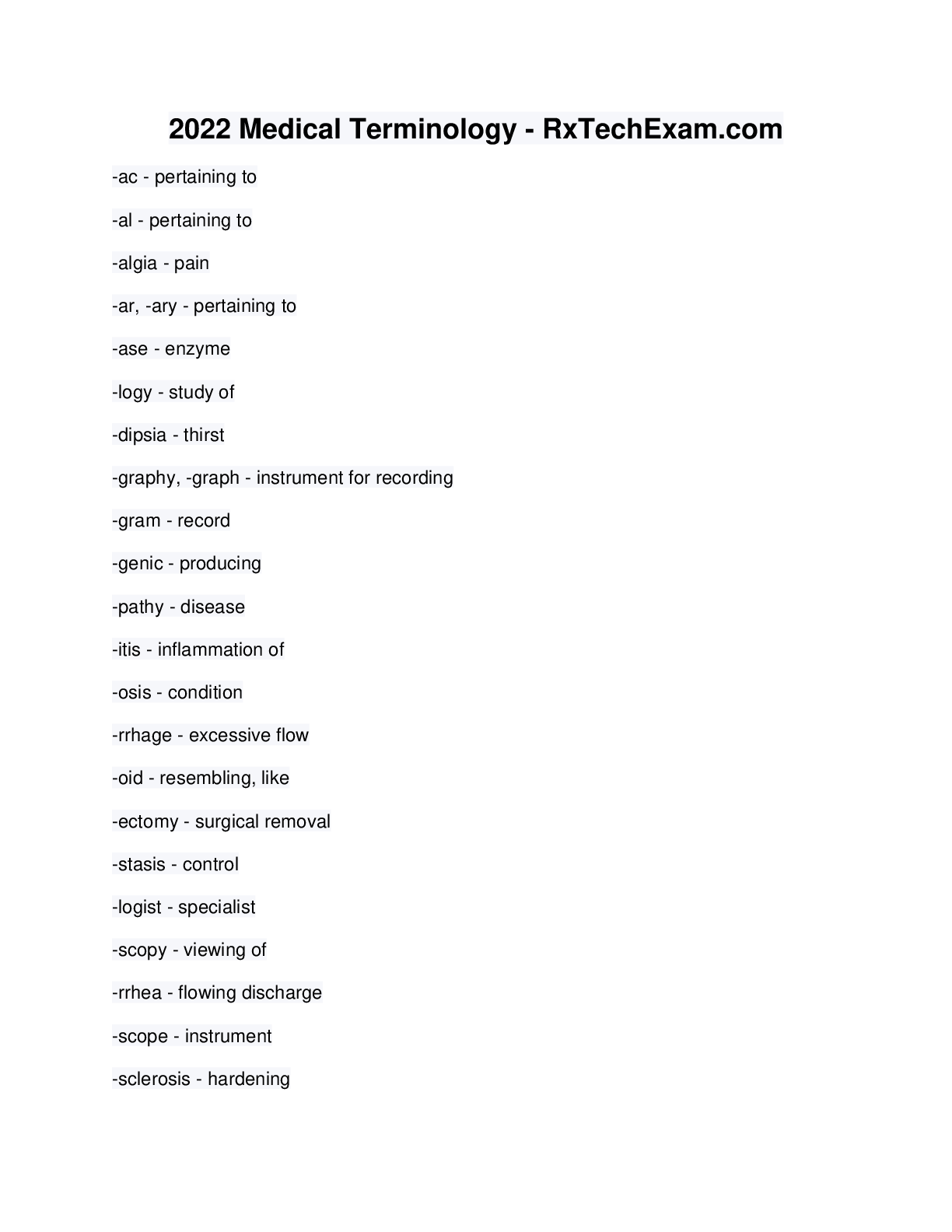

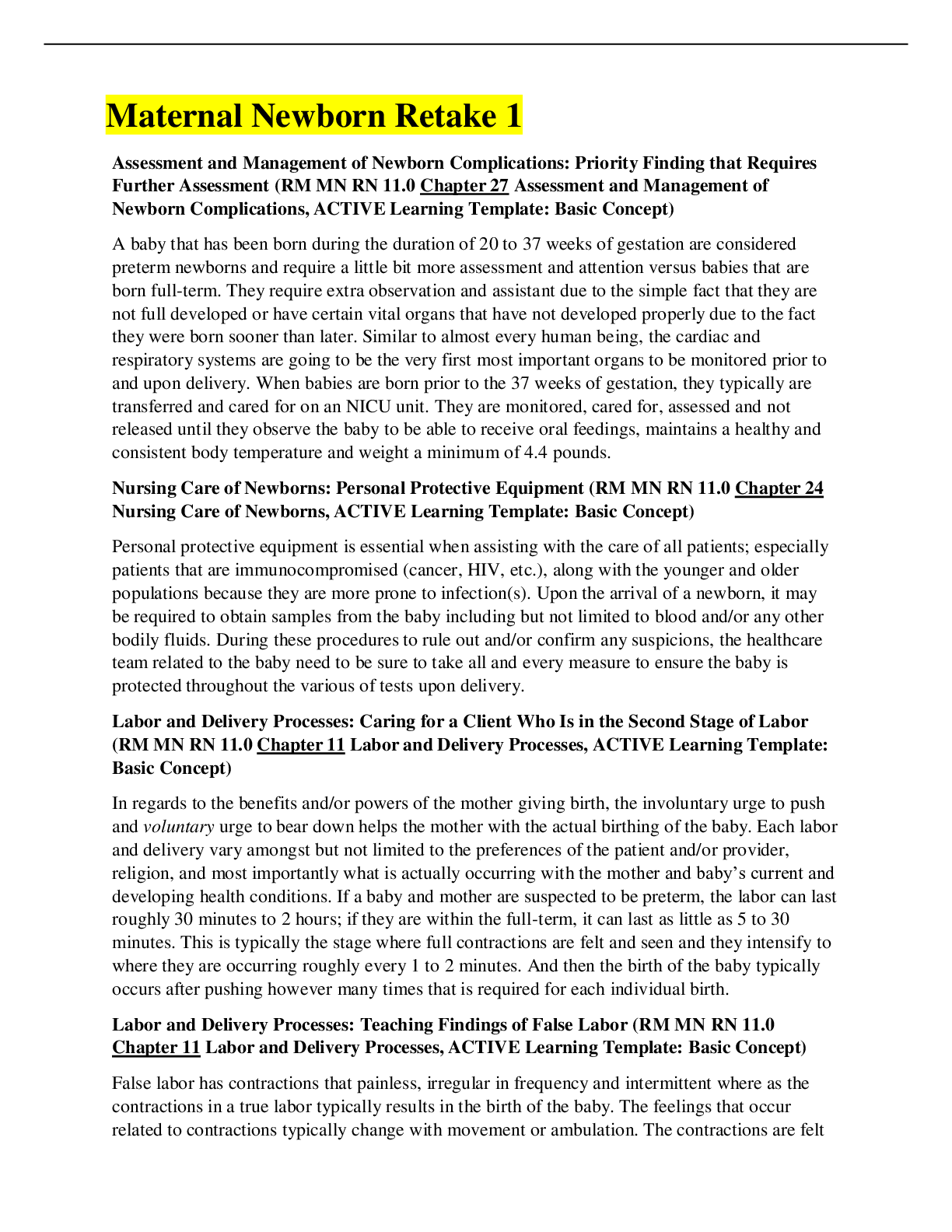

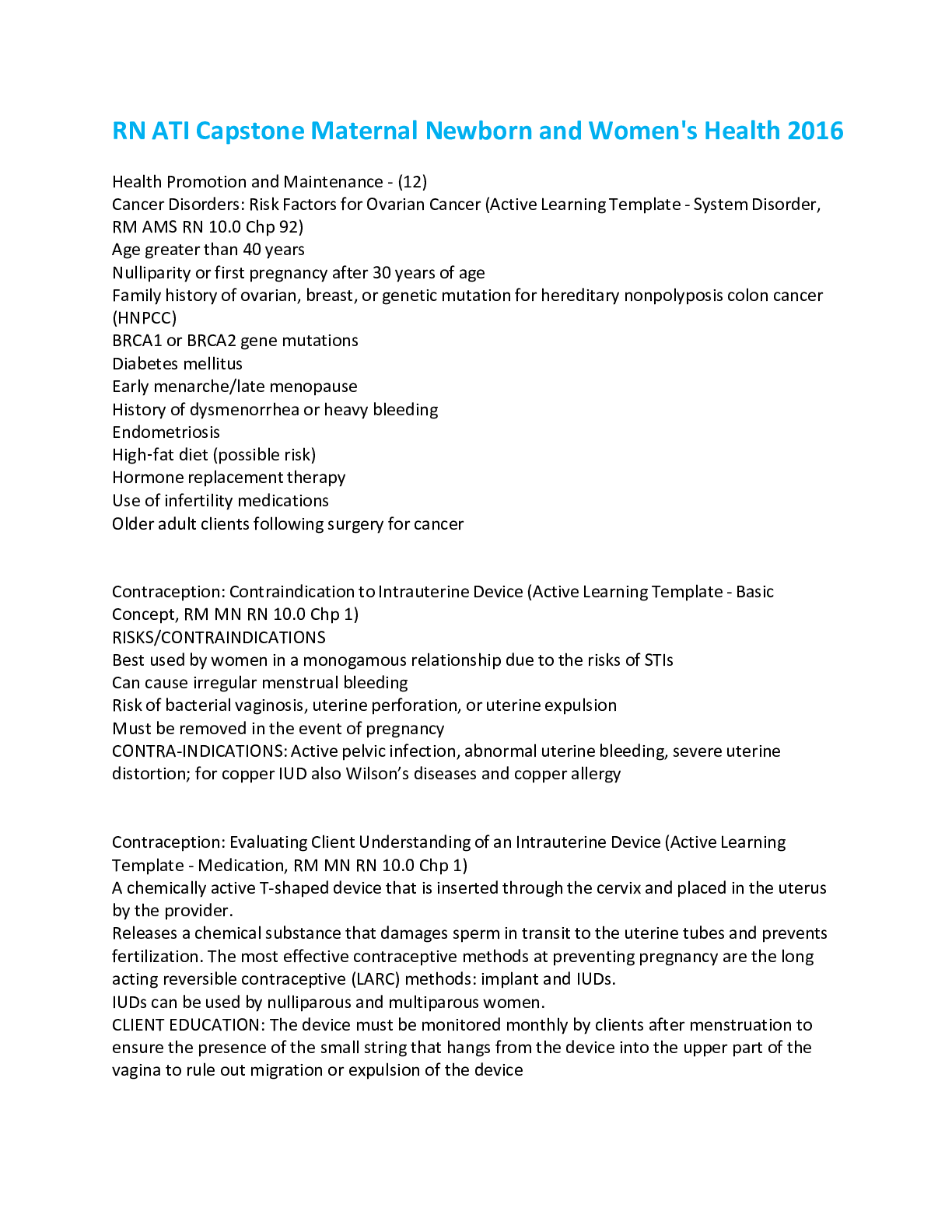
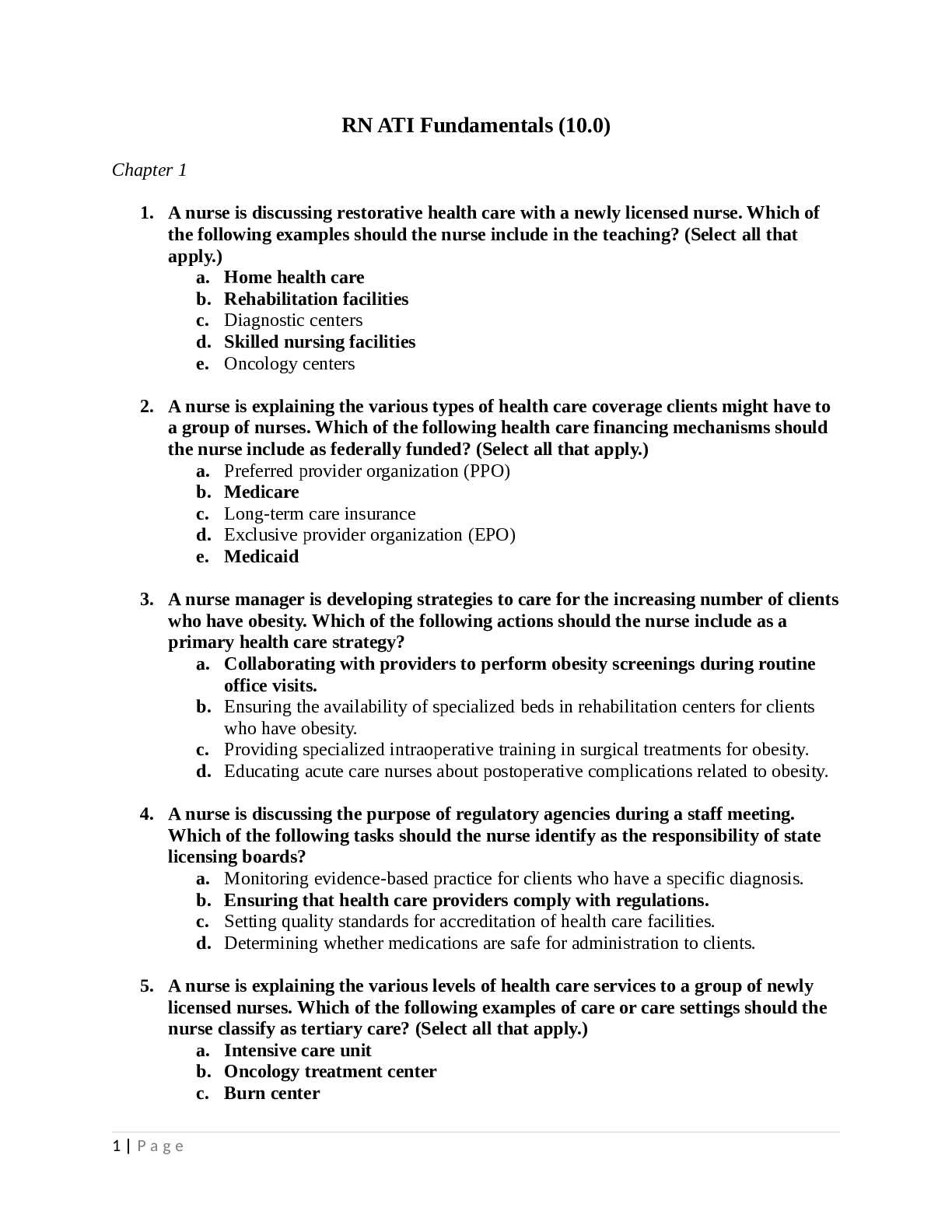

.png)
.png)
